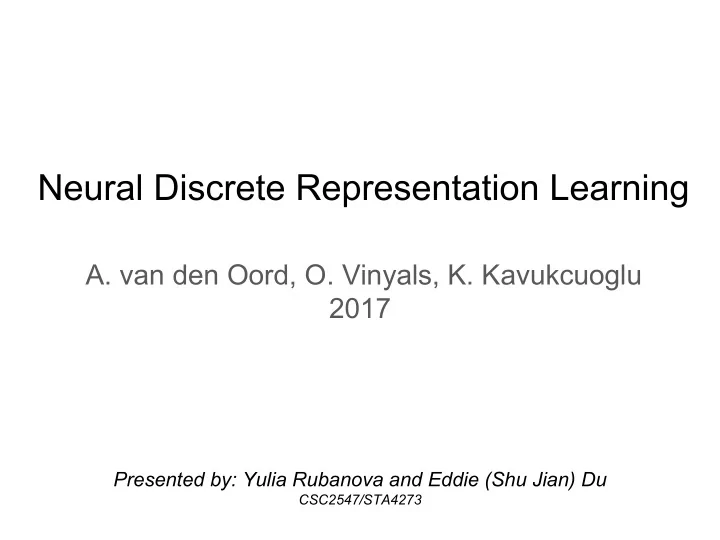

Neural Discrete Representation Learning A. van den Oord, O. Vinyals, K. Kavukcuoglu 2017 Presented by: Yulia Rubanova and Eddie (Shu Jian) Du CSC2547/STA4273
Introduction Vector quantization variational autoencoder (VQ-VAE) - VAE with discrete latent space Why discrete? - Many important real-world things are discrete (words, phonemes, etc.) - Learn global structure instead of noise and details - Achieve data compression by embedding into discrete latent space
Algorithm Step I: Input is encoded into continuous
Algorithm Step I: Input is encoded into continuous Step II: transforming into -- discrete variable over K categories
Algorithm Step I: Input is encoded into continuous Step II: transforming into -- discrete variable over K categories We define a latent embedding space (D is the dimensionality of each latent embedding vector)
Algorithm Step I: Input is encoded into continuous Step II: transforming into -- discrete variable over K categories We define a latent embedding space (D is the dimensionality of each latent embedding vector) To discretize : calculate a nearest neighbour in the embedding space
Algorithm The posterior categorical distribution -- deterministic!
Algorithm The posterior categorical distribution -- deterministic! Step III: use as input to the decoder
Algorithm The posterior categorical distribution -- deterministic! Step III: use as input to the decoder Reconstruction loss Model is trained as a VAE in which we can bound log p(x) with the ELBO.
Training How can we get a gradient for this?
Training How can we get a gradient for this? Just copy gradients from decoder input to encoder output (straight-through estimator)
Training How can we get a gradient for this? Just copy gradients from decoder input to encoder output (straight-through estimator) Main idea: Gradients from decoder contain information for how the encoder has to change its output to lower the reconstruction loss.
How do we train embeddings? Embedding don’t get gradient from reconstruction loss
How do we train embeddings? Embedding don’t get gradient from reconstruction loss Use L2 error to move the embedding vectors towards Embedding loss = sg = stopgradient operator
Training
How to reconstruct an image? Discrete z : a field of 32 x 32 latents (ImageNet), K=512 32 32 Discrete categories for each patch
How to reconstruct an image?
Experiments & Results
ImageNet - Reconstruction 128x128x3 images ↔ 32x32x1 discrete latent space (K=512) Original Reconstruction
128x128x3x(8 bits per pixel) / 32x32x(9 bits to index a vector) ImageNet - Recon = 42.6 times compression in bits 128x128x3 images ↔ 32x32x1 discrete latent space (K=512) Original Reconstruction
ImageNet - Samples Train PixelCNN on the 32x32x1 discrete latent space. Sample from PixelCNN, decode with VQ-VAE decoder.
ImageNet - Samples Train PixelCNN on the 32x32x1 discrete latent space. Sample from PixelCNN, decode with VQ-VAE decoder.
ImageNet - Samples Train PixelCNN on the 32x32x1 discrete latent space. Sample from PixelCNN, decode with VQ-VAE decoder. Learn an autoregressive prior over discrete z ● PixelCNN for images ● WaveNet for raw audio PixelCNN PixelRNN Image Source: https://towardsdatascience.com/summary-of-pixelrnn-by-google-deepmind-7-min-read-938d9871d6d9
ImageNet - Generation Microwave pickup tiger beetle coral reef brown bear
DeepMind Lab - Reconstruction 84x84x3 images ↔ 21x21x1 discrete latent space (K=512) ↔ 3x1 discrete latent space (K=512) Two VQ-VAE layers! 3x9 = 27 bits in latent representation. Can’t reconstruct exactly, but does capture global structure.
DeepMind Lab 84x84x3 images ↔ 21x21x1 discrete latent space (K=512) ↔ 3x1 discrete latent space (K=512) Source: https://avdnoord.github.io/homepage/slides/SANE2017.pdf
DeepMind Lab - Reconstruction Original “Reconstruction”
Audio (VCTK) - Reconstruction Use WaveNet decoder. Source: https://avdnoord.github.io/homepage/slides/SANE2017.pdf
Audio (VCTK) - Reconstruction Original Reconstruction Again, not exact reconstruction, but captures global structure. (More examples at https://avdnoord.github.io/homepage/vqvae/)
Audio (LibriSpeech) - Latents == phonemes? It turns out discrete latent variables roughly correspond to phonemes. Note that the semantics of discrete codes could be dependent on previous codes; so it’s interesting that individual discrete codes actually hold meaning! Source: https://avdnoord.github.io/homepage/slides/SANE2017.pdf
Audio (LibriSpeech) - Sampling Example Source: https://avdnoord.github.io/homepage/slides/SANE2017.pdf
Audio (LibriSpeech) - Change Speaker Identity Original Transferred => Discrete latent variables are not speaker-specific! Source: https://avdnoord.github.io/homepage/slides/SANE2017.pdf
Summary - Pros: - Learn meaningful representations with global information - Can model long range sequences - Fully unsupervised - Avoids “posterior collapse” issue - Model features that usually span many dimensions in data space - Cons: - Straight-through estimator is biased - Compression relies on large lookup tables
Recommend
More recommend